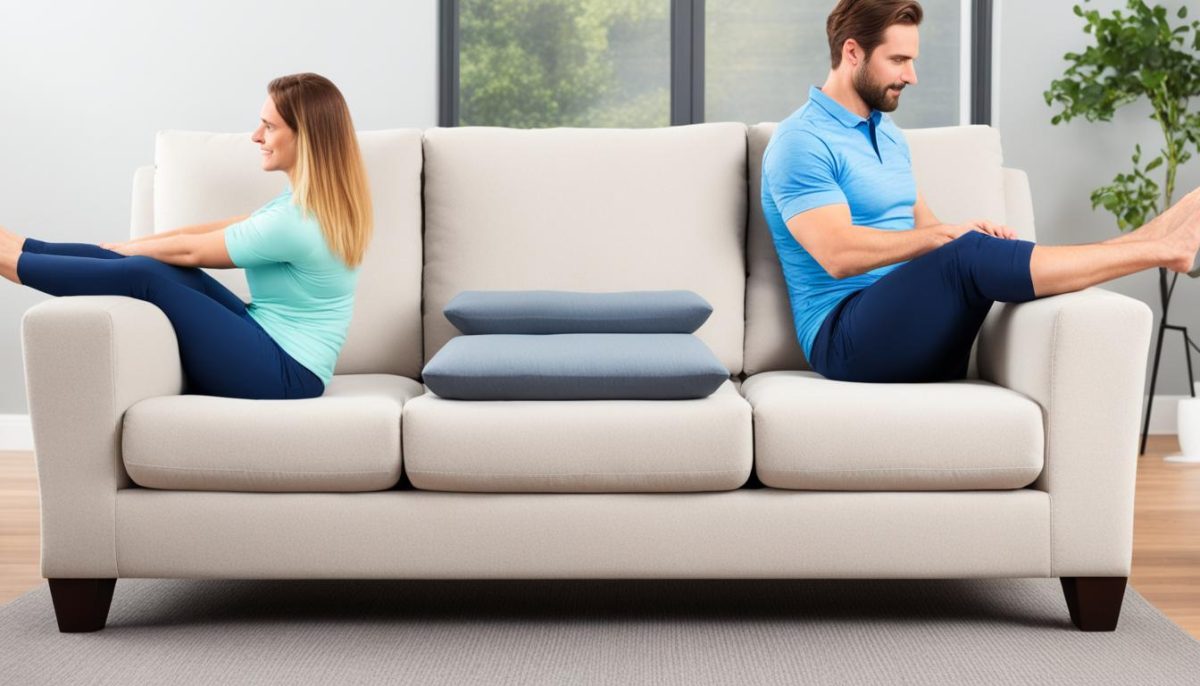Welcome to our comprehensive guide on understanding couch weight. Whether you’re planning to move or looking to purchase a new couch, understanding its weight is essential. In this article, we will explore the factors that determine how much a couch weighs and provide you with expert insights to help you make informed decisions.
Knowing the weight of a couch is crucial for several reasons. When moving, it helps you plan logistics and ensure that you have the necessary manpower or equipment. Additionally, when purchasing a new couch, understanding its weight can help you determine if it meets your space requirements or if it’s easily movable.
In the following sections, we will dive into the factors influencing couch weight, explore the average weights of different types of couches, provide tips on measuring and weighing a couch accurately, and discuss lightweight couch options. We will also offer advice on how to safely move and transport a couch, as well as considerations for purchasing a couch based on weight.
By the end of this guide, you’ll have a complete understanding of couch weights and the impact various factors have on them. Armed with this knowledge, you’ll be better equipped to choose the right couch for your needs and maintain its longevity. Let’s get started!
Factors Influencing Couch Weight
When it comes to the weight of a couch, several factors come into play. Understanding these factors can help you determine what contributes to the overall weight of a couch and why they may vary. From the materials used to construct the couch to its size and design, here are some key elements that influence couch weight:
- Frame Material: The material used for the couch’s frame can significantly impact its weight. For example, a couch with a solid wood frame will generally be heavier than one with a metal or particleboard frame.
- Upholstery Material: The type of upholstery material chosen for a couch can also affect its weight. Fabrics like velvet or leather tend to be heavier than lighter materials like linen or microfiber.
- Cushioning: The cushioning used in the couch, such as foam or down, can contribute to its weight. Cushions filled with down feathers will generally be lighter than those filled with foam or other synthetic materials.
- Size and Dimensions: It’s no surprise that the size and dimensions of a couch play a significant role in its weight. A larger couch with more seating space and a longer length will generally be heavier than a smaller couch.
- Construction: The way a couch is constructed can impact its weight. For example, couches with additional support features like reinforced frames or extra springs may weigh more than those with simpler construction.
Keep in mind that these factors can vary depending on the specific couch model or brand. It’s always a good idea to check the manufacturer’s specifications or consult with a furniture expert to get accurate details about a particular couch’s weight.
Understanding the factors influencing couch weight can be helpful when selecting a new couch or comparing different options. Whether you prioritize a lighter couch for easier maneuverability or prefer a sturdier and more substantial piece, considering these factors will ensure you make an informed decision.
Average Couch Weights by Material
| Material | Average Weight (lbs) | Example |
|---|---|---|
| Leather | 150-250 | |
| Fabric | 100-200 | |
| Microfiber | 80-150 | |
| Velvet | 120-200 |
Different Types of Couches and Their Average Weights
When it comes to choosing a couch, understanding the average weights of different types can help you make an informed decision. Whether you’re looking for a sectional sofa, a loveseat, a recliner, or a sleeper sofa, knowing the typical weight range for each type can guide your selection process.
To give you an idea of the average weights, here is a table comparing different types of couches:
| Couch Type | Average Weight Range | Key Features |
|---|---|---|
| Sectional Sofa | 300-900 pounds | Modular design, multiple sections |
| Loveseat | 100-300 pounds | Compact size, seats two people |
| Recliner | 80-300 pounds | Adjustable backrest and footrest |
| Sleeper Sofa | 150-500 pounds | Convertible design, doubles as a bed |
These average weight ranges can vary depending on factors such as the size, materials used, and additional features of the couch. It’s essential to consider these factors along with your specific needs and preferences when choosing the right couch for your home.
Factors Influencing Weight Variation
It’s worth noting that the weight of a couch can also vary within each type due to factors such as the frame construction, cushioning materials, and upholstery fabric chosen by the manufacturer. Some couches may be designed to be more lightweight, while others prioritize sturdiness and durability.
It’s always a good idea to check the product specifications provided by the manufacturer or retailer to ensure that the couch you are interested in meets your weight requirements.
Understanding the average weights of different types of couches can help you narrow down your options and find a couch that not only fits your style but also matches your weight preferences. Remember to consider the size of your space, the weight capacity of your floor, and any specific mobility needs when making your final decision.
How to Measure and Weigh a Couch
Accurately measuring and weighing a couch is essential for various reasons, whether you’re planning a move or comparing options while furniture shopping. By following these practical tips, you can ensure accurate measurements and make informed decisions.
1. Measuring the Dimensions
Before weighing a couch, start by measuring its dimensions. Use a tape measure to determine the length, width, and height of the couch. Measure from the outer edges, including any protruding elements such as armrests or decorative details. Note down these measurements for reference.
2. Preparing the Couch for Weighing
Prior to weighing the couch, it’s important to prepare it properly. Clear any items or cushions from the couch, ensuring it is empty and ready for weighing. If the couch has removable parts, such as cushions or detachable legs, take them off to get a more accurate weight measurement.
3. Using a Bathroom Scale
A simple and accessible method for weighing a couch is by using a bathroom scale. Place the scale on a flat, stable surface, and make sure it is set to zero before placing the couch on top. Carefully lift one side of the couch, positioning it on the scale, then repeat the process for the other side. Add the weights together to get the overall weight of the couch.
4. Hiring Professional Movers or Packers
If you’re unable to weigh the couch yourself or prefer a hassle-free approach, consider hiring professional movers or packers. These experts have the necessary equipment and experience to accurately weigh your couch and handle the entire moving process, ensuring your couch is transported safely.
With these handy tips, you can confidently measure and weigh your couch. Remember to record the dimensions and weight for future reference, whether you need it for moving purposes or to compare different couch options. This knowledge will empower you to make informed decisions and find the perfect couch for your space.
Lightweight Couch Options
If you’re looking for a couch that offers easy mobility or need to adhere to specific weight restrictions, we’ve got you covered. In this section, we will explore some lightweight couch options that prioritize both comfort and durability without compromising on style. Let’s dive in!
Sleek and Modern
If you’re a fan of sleek and modern designs, consider the Nordic Sofa. Crafted with lightweight yet sturdy materials like aluminum or engineered wood, this couch offers a contemporary aesthetic without weighing you down. Its minimalist frame and clean lines make it an excellent choice for small spaces or those seeking a minimalist approach to decor.
Travel-Friendly
For those always on the move or frequently rearranging their living space, the Roamer Sectional is worth considering. This modular couch allows for easy customization, allowing you to adapt it to various room layouts. The lightweight construction and detachable components ensure hassle-free transportation, making it an ideal choice for frequent movers or those who simply enjoy changing scenery.
Compact and Versatile
If you’re working with limited space, the Studio Loveseat is a fantastic lightweight option. This compact couch not only offers a comfortable seating solution but also doubles as a guest bed when needed. Its innovative design incorporates lightweight materials without compromising on support and durability, making it a versatile choice for small apartments, home offices, or guest rooms.
Lightweight couch options provide the perfect blend of mobility, style, and functionality. Whether you’re searching for a modern centerpiece, a couch that travels with you, or a space-saving solution, there are numerous options available to suit your specific needs.
| Couch Model | Weight | Material | Design |
|---|---|---|---|
| Nordic Sofa | 25 lbs | Aluminum or Engineered Wood | Sleek and Modern |
| Roamer Sectional | 30 lbs | Lightweight materials | Modular and Travel-Friendly |
| Studio Loveseat | 20 lbs | Lightweight materials | Compact and Versatile |
Table: Lightweight Couch Recommendations
These lightweight couch options are just a sample of what’s available in the market. Consider your specific needs, room size, and personal preferences when selecting the best lightweight couch for your space. With the right choice, you can enjoy the convenience of easy mobility without compromising on style and comfort.
Moving and Transporting a Couch
When it comes to moving a couch, proper preparation and techniques are essential to avoid damage to the furniture and injuries. Whether you’re relocating to a new home or rearranging your living space, follow these tips for a smooth and hassle-free couch-moving experience.
Preparing the Couch for Moving
Before you start moving your couch, take some time to prepare it properly:
- Remove any removable parts, such as cushions or legs, and pack them separately to prevent damage.
- Clean the couch thoroughly to ensure no dirt or debris is transferred to your new location.
- Wrap the couch in a protective material, such as moving blankets or plastic wrap, to prevent scratches or tears during transit.
Utilizing Proper Lifting Techniques
Moving a heavy couch can be challenging, but using the right lifting techniques can make it much easier:
- Always bend at the knees and use your leg muscles rather than straining your back when lifting.
- Enlist the help of a friend or family member to assist with the lifting.
- Use lifting straps or sliders to distribute the weight evenly and reduce strain on your body.
Hiring Professional Movers
If moving a heavy couch seems too daunting or you have limited physical capabilities, consider hiring professional movers. They have the skills, experience, and equipment necessary to move your couch safely and efficiently. Research reputable moving companies in your area and request quotes to find the best option for your needs.
“Hiring professional movers can save you time, effort, and potential injury. It’s a worthwhile investment, especially when dealing with large or fragile furniture like couches.” – Emma Johnson, Experienced Mover
Couch Moving Tips
In addition to the above steps, here are some additional tips to ensure a successful couch move:
- Measure doorways and hallways in both your current and new homes to ensure the couch can fit through without causing any damage or requiring disassembly.
- Secure the wrapped couch with straps or ropes to prevent shifting during transportation.
- Consider using furniture sliders or moving dollies to make it easier to maneuver the couch, especially if you have to navigate stairs or tight spaces.
Weight Considerations When Purchasing a Couch
When buying a new couch, it’s important to take weight considerations into account. Understanding how the weight of a couch can impact your home requirements is crucial for making an informed decision. Here are a few factors to keep in mind:
1. Weight Capacity of Your Floor
Before choosing a couch, it’s essential to consider the weight capacity of your floor. Some floors, especially in older homes or apartments, may have weight restrictions. The last thing you want is to purchase a heavy couch that exceeds your floor’s weight limit, potentially causing damage.
2. Easy Maneuverability
If you have a small or narrow space, such as a cozy apartment or a room with tight doorways, you’ll want to prioritize a couch that is easy to maneuver. Opting for a lighter couch will make it easier to navigate through narrow spaces, reducing the risk of damage to your walls or furniture.
3. Accessibility
Consider if there are any accessibility requirements in your home. For example, if you or someone in your household has mobility challenges, a lighter couch may be easier to move or reposition as needed. This can enhance comfort and convenience for everyone in your home.
By considering weight along with other factors such as style, comfort, and size, you can find the perfect couch that fits seamlessly into your living space. Whether you prioritize easy maneuverability or need to stay within a specific weight limit, taking weight considerations into account is essential for a well-informed purchase.
| Couch Model | Weight (lbs) |
|---|---|
| Sofa-A | 150 |
| Sectional-B | 250 |
| Recliner-C | 120 |
| Loveseat-D | 180 |
Maintaining Couch Weight Distribution
Proper weight distribution is essential for maintaining the longevity and comfort of your couch. Over time, uneven weight distribution can lead to sagging, indentations, and compromised structural integrity. To ensure that your couch stays in optimal condition, follow these tips:
1. Rotate and Flip Cushions Regularly
One effective way to distribute the weight evenly on your couch is by rotating and flipping the cushions regularly. By doing so, you prevent the same areas from bearing the weight consistently, reducing the risk of sagging and indentations. Aim to rotate and flip the cushions at least once a month for even weight distribution.
2. Use a Sofa Slipcover
A sofa slipcover not only adds a decorative touch to your couch but can also help distribute the weight more evenly. Slipcovers offer an extra layer of padding and protection, preventing excessive pressure on specific areas. Additionally, they can be easily removed and washed, helping to maintain the cleanliness and freshness of your couch.
3. Avoid Concentrated Weight
Avoid placing heavy items or sitting in the same spot on your couch repeatedly. Concentrated weight in one area can cause uneven distribution, leading to sagging and increased wear and tear. Encourage everyone in your household to choose different seating spots and distribute weight evenly across the couch.
4. Consider Cushion Fillings
The type of cushion fillings used in your couch can also impact weight distribution. Opt for high-quality foam or down-filled cushions, as they are more resistant to sagging and provide better weight distribution. Avoid inexpensive or low-density foam that may compress quickly and unevenly under weight.
5. Reinforce Sagging Areas
If your couch already shows signs of sagging or indentations, you can reinforce the affected areas to improve weight distribution. Place plywood or sturdy boards under the cushions or utilize specially designed couch supports to provide additional support and prevent further sagging.

By following these tips for maintaining even weight distribution on your couch, you can ensure its longevity and comfort for years to come. Remember to consistently assess the weight distribution, rotate and flip cushions, and make necessary adjustments to prevent sagging and maintain the overall integrity of your couch.
Conclusion
Now that you have gained a comprehensive understanding of couch weights and the various factors that influence them, you are equipped to make informed decisions when it comes to moving, purchasing, or maintaining a couch. The weight of a couch plays a crucial role in ensuring a hassle-free experience and the longevity of your furniture.
By utilizing the knowledge and insights provided in this guide, you can confidently choose a couch that suits your specific needs and preferences. Whether you are looking for a lightweight option for easy mobility or considering weight capacity for your home, this resource will help guide you in the right direction.
Remember, measuring and weighing your couch accurately is essential, especially when it comes to moving or comparing different options. Additionally, maintaining proper weight distribution will help prevent sagging and ensure the overall comfort and durability of your couch.
As you embark on your couch-buying journey, use this guide as your go-to resource. With a comprehensive understanding of couch weights, you can now navigate the world of furniture with confidence, ensuring a comfortable and long-lasting addition to your home.




